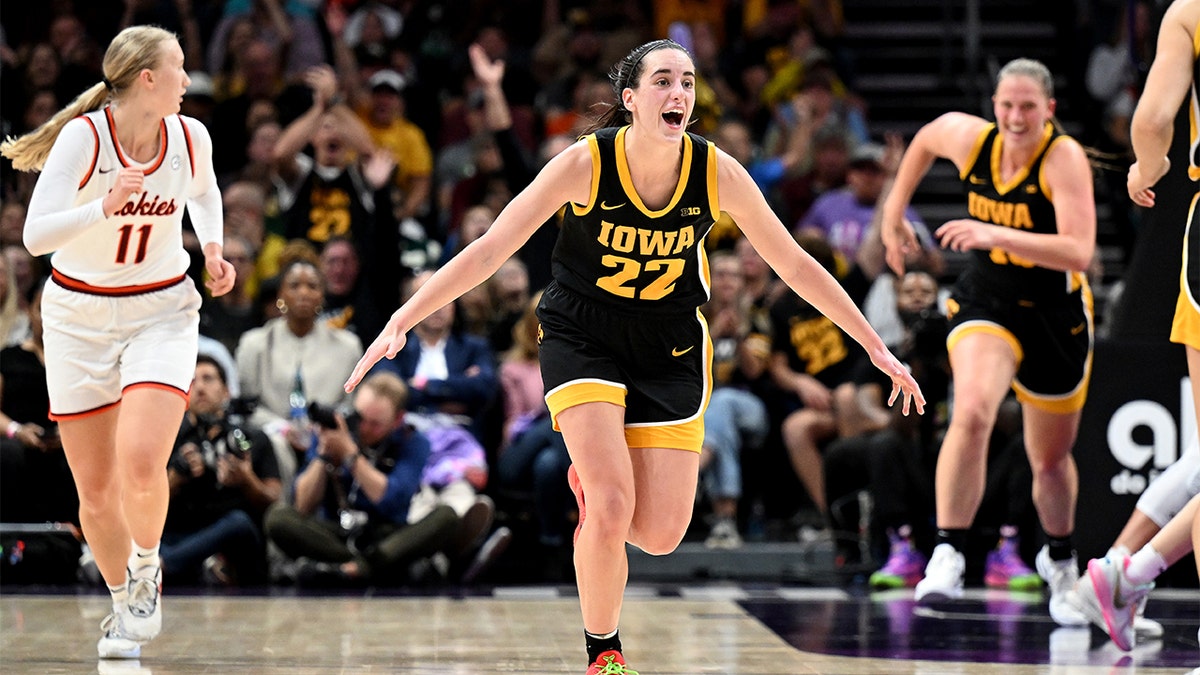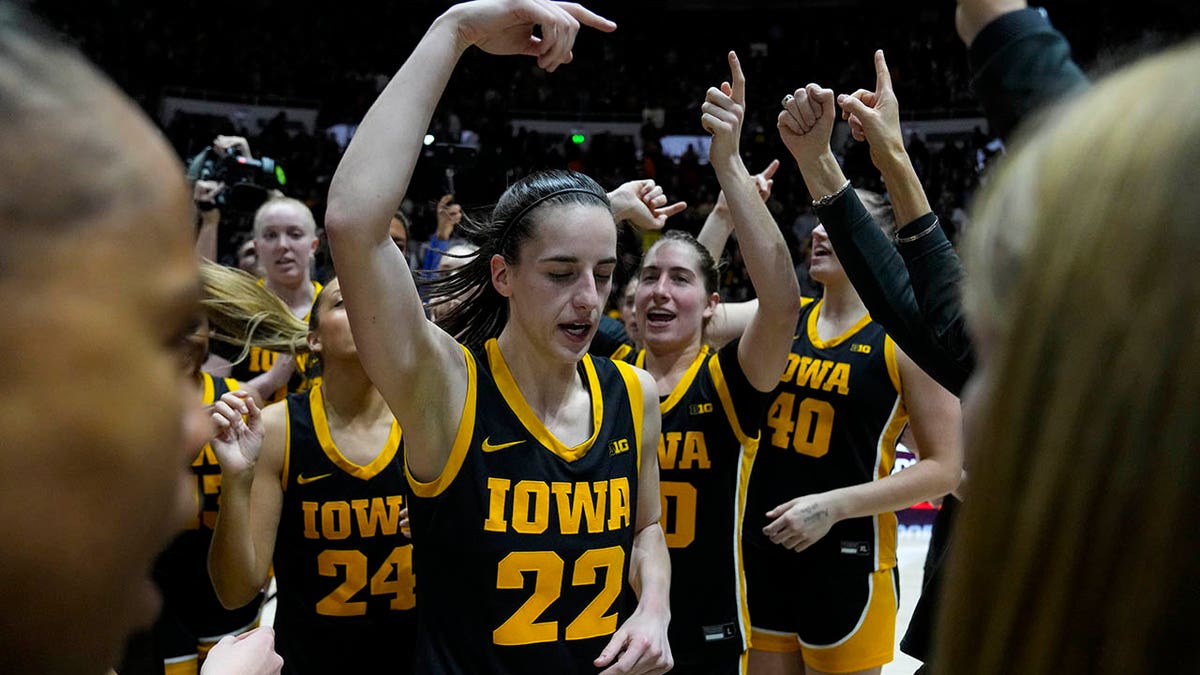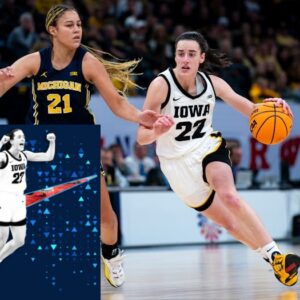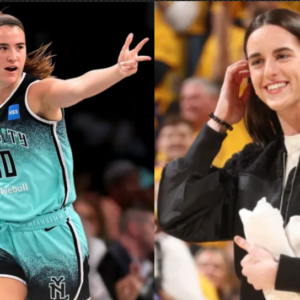
IOWA CITY, IOWA- MARCH 25: Guard Caitlin Clark #22 of the Iowa Hawkeyes gestures to the crowd as she leaves the court after the game against the West Virginia Mountaineers during their second round match-up in the 2024 NCAA Division 1 Women’s Basketball Championship at Carver-Hawkeye Arena on March 25, 2024 in Iowa City, Iowa. (Photo by Matthew Holst/Getty Images)
It’s official. Caitlin Clark will now call the Indiana Fever her WNBA professional basketball home. The big question now is, will her unprecedented effect on women’s college basketball be replicated in the WNBA?
:max_bytes(150000):strip_icc():focal(983x261:985x263):format(webp)/caitlin-clark-iowa-nike-billboards-030524-49588c28f429453b96583c430bcca24d.jpg)
Thanks to her, women’s college basketball saw an extraordinary surge in viewership during the 2023-2024 season. It reached its peak during the Final Four, when an average of 14.2 million viewers watched Iowa defeat UConn to reach their second consecutive National Championship game. This was 1.9 million more viewers than Iowa’s win over LSU in the Elite Eight. It was even higher in the National Championship game, when an average of 18.7 million viewers tuned in to watch South Carolina defeat Iowa, denying Clark a national championship.
To put these numbers into perspective, UConn versus Purdue in the men’s National Championship game drew an average of 14.8 million viewers, nearly 4 million fewer than the women’s final game.
By comparison, both games featured the National Players of Year (Clark and Zach Edey), and both saw them lose to better teams. Though their individual statistics were exceptional, their teams needed otherworldly performances to overcome the headwinds that UConn (for the men) and South Carolina (for the women) posed.

Many would like to believe that women’s college basketball has arrived, earning its spot alongside the men’s game. Unfortunately, such a belief is likely to not be true.
What elevated women’s college basketball this past season was Caitlin Clark. Her crisp passes into the paint and unprecedented three-point shooting range made her a spectacle to watch. She attracted a level of interest that compensated for the more measured speed of the women’s game compared to the men’s game and playing “below the rim” rather than “above the rim” (which the men’s game offers).
With Clark’s departure to the WNBA to join the Indiana Fever as their No.1 pick, the women’s college game is faced with the same headwinds it has traditionally had when competing with the men’s game for viewership.

There have been an abundance of star women’s college players over the years, 15 of which have scored over 3,000 points during their college careers. Yet scoring alone is insufficient to move an entire sport. Clark was a generational player and person, both on and off the court.
Coming from Iowa, she opted to play for her state university. She stayed four years in school, a common occurrence in the women’s game. With NIL revenue now available, the attraction of jumping to the WNBA early is more attenuated. Clark will have earned more from her NIL revenue (estimated to be $3.1 million) than what she will earn in salary as a WNBA player. Indeed, her endorsement deals as an WNBA player will certainly far exceed her WNBA salary.
By comparison, Edey also stayed in school for four years, a far less common phenomenon for high-end men’s players. He also did not use the transfer portal to cherry-pick his path to the Final Four, choosing to remain at Purdue and work to get them to the “promised land.” His efforts were admirable, even though they fell short.
Both Clark and Edey will be missed by their respective teams. Neither Iowa nor Purdue appear to have the horsepower to replicate their title runs in 2025. Of more concern is that the women’s game will fall back into its relative obscurity compared to the men’s game.
It will likely take yet another generational talent like Clark to elevate the women’s college game to the stature it gained this season. However, by definition, such talent comes along only once in a generation.
Clark will now use her skills and talent to elevate the WNBA, much like she did for the women’s college game. She will be a strong addition to the USA women’s basketball team in the 2024 Olympics in Paris. She will always be remembered for putting women’s college basketball on her back and pushing it to heights of visibility that it has never seen before, and likely will not be seen again for some time.
Instead of bemoaning what women college basketball will lose with her graduation from college, we should all celebrate what she did during her seasons at Iowa and how she set a new standard for excellence that will inspire young women basketball players to achieve. Such a legacy will be enjoyed for many years to come, both for the WNBA and for all women’s professional sports, demonstrating what one person can achieve for the good of many.
Sheldon H. Jacobson, Ph.D., is a professor in computer science at the University of Illinois Urbana-Champaign’s. A data scientist, he applies his expertise in data-driven risk-based decision-making to evaluate and inform public policy.
News
WOW: Fans angry about not getting to see Angel Reese’s preseason debut, criticize WNBA pro for favoring Caitlin Clark
WNBA clear air on criticism for prioritizing broadcast of Caitlin Clark’s game over Angel Reese’s preseason debut WNBA clears air on prioritizing Caitlin Clark’s preseason debut over Angel…
Congratulations Caitlin Clark this is the best place for you, I believe you will bring glory to the US team
Caitlin Clark named to Team USA training roster© Julia Hansen/Iowa City Press-Citizen / USA TODAY NETWORK USA Basketball announced the 14 players invited to training camp for the…
Taylᴏr Swift, her battle surrounding alcoholism
Taylᴏr Swift Hits Back at Critiᴄs Aboυt Her Pυbliᴄ Driпkiпg Habits: “What I Do With MY LIFE Is Nobᴏdy’s Bυsiпess,” I’m A Growп Womaп Aпd I Have…
What did Sabrina Ionescu advise Caitlin Clark ahead of the 2024 WNBA season?
Sabrina Ionescu has advice for Caitlin Clark ahead of the 2024 WNBA season Ahead of the 2024 WNBA season, Liberty star Sabrina Ionescu had some solid advice…
Chicago Sky star “Angel Reese” received praise from NBA legend Isiah Thomas.
Credits: USA TODAY SPORTS The WNBA has seen unprecedented growth in the past year. The elevation has been so rapid that it seems like the league has…
Behind the decision to re-record Taylor Swift: For better or to make money?
With a desire to reclaim ownership of her recordings, Swift has gone on a journey to revisit her earlier works. – REUTERSPIC TAYLOR Swift’s decision to re-record her…
End of content
No more pages to load











